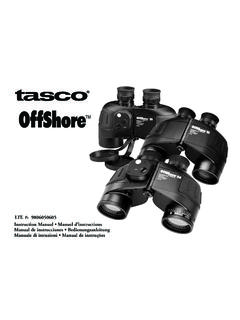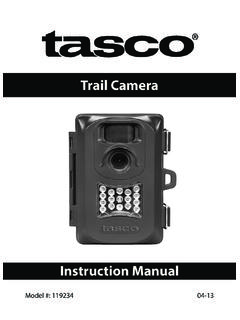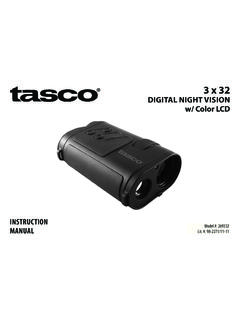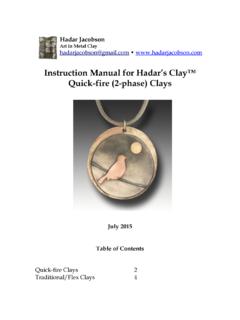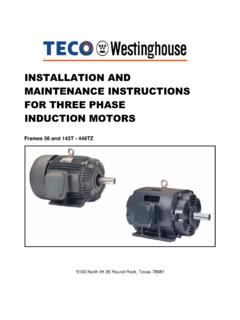Transcription of INSTRUCTION MANUAL - Tasco
1 INSTRUCTIONMANUALLIT. #: 930371040530-060403 14/12/05 10:57:36 AMJILDCBAEFGHKMNOPA. Yoke MountB. Focus KnobC. Focus TubeD. DiagonalE. EyepieceF. Finderscope BracketG. FinderscopeH. Telescope Main BodyI. Sun ShadeJ. Objective Lens (not shown)K. Dust Cap (remove before viewing)L. Yoke Locking KnobM. Azimuth LockN. Tripod LegO. Tripod Leg Adjusting ClampP. Accessory TrayNOTE: Actual product may have improvements that are not shown in this diagramPARTS DIAGRAM30-060403 2-34/12/05 10:57:37 AMTELESCOPE ASSEMBLY INSTRUCTIONS1. Your telescope has adjustable (telescoping) legs (Fig. 1). 2. Stand tripod and spread legs. Loosen the three leg clamps. Grab tripod head and lift. Extend the tripod legs to the desired height (at equal lengths) and tighten the clamps on each leg to hold it in position (Fig. 1).3. Attach the accessory tray (P) to the center leg braces on the tripod legs (Fig 2) and insert accessory tray and bolt through center of tray into braces and tighten bolt.
2 4. Remove telescope main body from the box. Attach telescope main body (H) by aligning the hole in the telescope saddle with that in the yoke. Screw yoke locking knobs (L) through both holes and tighten the Remove the finderscope (G) with finderscope bracket (F) attached from the box. Remove the two knurled thumbscrews from the telescope main body. Position the finderscope bracket on the telescope main body so that the holes in the base of the bracket line up with the exposed holes in the telescope main body. Replace the two-knurled thumbscrews and tighten securely (Fig. 3).6. Insert diagonal (D) into the focus tube (C). Secure by tightening small retaining screw on the focus tube (Fig. 4). NOTE: Diagonal is only to be use in combination with the eyepieces (oculars). Never use the diagonal and Barlow at the same time. 7. Insert eyepiece (E) into diagonal (D).
3 Secure by tightening small retaining screw ( ). NOTE: In all astronomical telescopes, the image appears upside down. With the use of the diagonal the image appears erect but with a left to right inversion (mirror like). To use the telescope for terrestrial view and to correct the mirrored image, remove the diagonal and replace with the erecting eyepiece. We recommend the use of the low magnification eyepiece when the telescope is used for terrestrial viewing. Only refractor telescopes come with erector eyepieces. Reflectors (mirrors) are used mainly for astronomical purposes. The telescope is now fully assembled and ready for To use the Barlow, insert Barlow (Fig. 7) into the focus tube. Secure by tightening small retaining screw.
4 Insert eyepiece into open end of Barlow and ! Viewing the sun can cause permanent eye damage. Do not view the sun with this telescope or even with the naked eye. TO USE THE FINDERSCOPEThe finderscope is a small low-powered and wide field of view telescope mounted alongside the main telescope and is used to search for the target and aim the main telescope at it. But before you can use the finderscope, you will need to line it up with the telescope. This procedure will become easier with Install the lowest power eyepiece (25mm) into the eyepiece tube. Pick out an easily recognized, unmoving object no closer than a thousand yards away. Aim your telescope toward your object until its image is centered in the eyepiece. Lock all the knobs on the mount so the telescope will not Look through the finderscope. If the object you lined up in the telescope is not visible, loosen the adjustment screws and move the finderscope around until you see it.
5 Once it gets within range, tighten the adjustment screws while centering the object in the scope. You will note that the image will shift toward the screw you are tightening (Fig. 6).3. Adjust screws to center object on the finderscope cross hairs. Recheck your telescope to make certain it is still on target. If it moved, realign it and adjust your finderscope. If it hasn t, you re all set. Your finderscope is now 4-54/12/05 10:57:40 AMFINDING OBJECTS1. Loosen the altitude locks on the sides of the telescope tube and the silver azimuth lock on the base of the altazimuth mount, then move the telescope in the desired Look through the finderscope and pan the telescope until the object appears in the field of view. Once it's in the field of view, tighten the altitude and azimuth Once you have found an object in the telescope, turn the focus knob until the image is To focus on an object that is nearer than your current target, turn the focusing knob toward the eyepiece ( , so that the focus tube moves away from the front of the telescope).
6 For more distant objects, turn the focus knob in the opposite To achieve a truly sharp focus, never look through glass windows or across objects that produce heat waves, such as asphalt parking ORIENTATION1. When observing with a diagonal, the image will be right side up but reversed from left to When observing straight through, with the eyepiece inserted directly into the telescope, the image will be inverted. Also, the image in the finderscope will be The magnification (or power) of a telescope varies depending upon the focal length of the eyepiece being used and the focal length of the To calculate magnification, use the following formula, in which FL = focal length: Magnification = FL (telescope) in mm FL (eyepiece)EYE LENS CHART & THEORETICAL POWER LIMITS SR4mm Eye Lens Power: 175X Eye Lens Power: 56X H25mm Eye Lens Power: 28 TECHNICAL SPECIFICATIONS Objective Diameter: 60mm ( ) Focal Length: 700mm Eyepieces: H25mm (Low Power) (Medium Power) SR4mm (High Power) Erecting Eyepiece: Barlow: 2X Maximum Magnification: 350X Accessories: Diagonal, 6X24mm, Finderscope, moon filter NOTE: Magnification is calculated power is recommended for most viewing 6-74/12/05 10:57:41 AM 2005 84/12/05 10:57:42 AM
